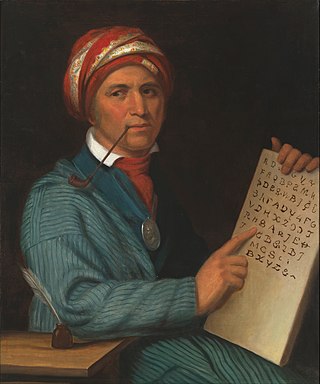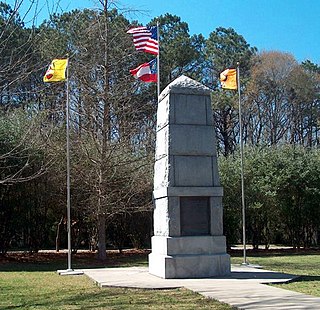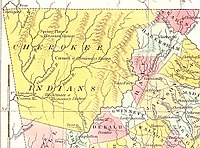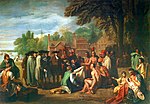
The Cherokee People are one of the Indigenous peoples of the Southeastern Woodlands of the United States. Prior to the 18th century, they were concentrated in their homelands, in towns along river valleys of what is now southwestern North Carolina, southeastern Tennessee, southwestern Virginia, edges of western South Carolina, northern Georgia and northeastern Alabama consisting of around 40,000 square miles

The Trail of Tears was the forced displacement of approximately 60,000 people of the "Five Civilized Tribes" between 1830 and 1850 by the United States government.

The Indian Removal Act of 1830 was signed into law on May 28, 1830, by United States President Andrew Jackson. The law, as described by Congress, provided "for an exchange of lands with the Indians residing in any of the states or territories, and for their removal west of the river Mississippi". During the presidency of Jackson (1829–1837) and his successor Martin Van Buren (1837–1841) more than 60,000 Native Americans from at least 18 tribes were forced to move west of the Mississippi River where they were allocated new lands. The southern tribes were resettled mostly in Indian Territory (Oklahoma). The northern tribes were resettled initially in Kansas. With a few exceptions, the United States east of the Mississippi and south of the Great Lakes was emptied of its Native American population. The movement westward of indigenous tribes was characterized by a large number of deaths occasioned by the hardships of the journey.
Worcester v. Georgia, 31 U.S. 515 (1832), was a landmark case in which the United States Supreme Court vacated the conviction of Samuel Worcester and held that the Georgia criminal statute that prohibited non-Native Americans from being present on Native American lands without a license from the state was unconstitutional. The opinion is most famous for its dicta, which laid out the relationship between tribes and the state and federal governments. It is considered to have built the foundations of the doctrine of tribal sovereignty in the United States.

John Ross was the Principal Chief of the Cherokee Nation from 1828 to 1866; he served longer in that position than any other person. Described as the Moses of his people, Ross influenced the nation through such tumultuous events as the relocation to Indian Territory and the American Civil War.

Tribal sovereignty in the United States is the concept of the inherent authority of Indigenous tribes to govern themselves within the borders of the United States.
The Nonintercourse Act is the collective name given to six statutes passed by the United States Congress in 1790, 1793, 1796, 1799, 1802, and 1834 to set boundaries of American Indian reservations. The various acts were also intended to regulate commerce between White Americans and citizens of Indigenous nations. The most notable provisions of the act regulate the inalienability of aboriginal title in the United States, a continuing source of litigation for almost 200 years. The prohibition on purchases of Indian lands without the approval of the federal government has its origins in the Royal Proclamation of 1763 and the Confederation Congress Proclamation of 1783.

The Treaty of New Echota was a treaty signed on December 29, 1835, in New Echota, Georgia, by officials of the United States government and representatives of a minority Cherokee political faction, the Treaty Party.

John Ridge, born Skah-tle-loh-skee, was from a prominent family of the Cherokee Nation that had a lot of status, then located in present-day Georgia. He went to Cornwall, Connecticut, to study at the Foreign Mission School And was very educated. He met Sarah Bird Northup, of a New England Yankee family, and they married in 1824. Soon after their return to New Echota in 1825, Ridge was chosen for the Cherokee National Council and became a leader in the tribe.

George Rockingham Gilmer was an American politician. He served two non-consecutive terms as the 34th governor of Georgia, the first from 1829 to 1831 and the second from 1837 to 1839. He also served multiple terms in the United States House of Representatives.
The Cherokee Freedmen controversy was a political and tribal dispute between the Cherokee Nation of Oklahoma and descendants of the Cherokee Freedmen regarding the issue of tribal membership. The controversy had resulted in several legal proceedings between the two parties from the late 20th century to August 2017.
United States v. Sandoval, 231 U.S. 28 (1913), was a United States Supreme Court case deciding whether the federal government's law prohibiting liquor on the land of Santa Clara Pueblo impermissibly infringed on the State of New Mexico's police power under the equal footing doctrine. In a unanimous decision, the Court upheld the law and Congress's ability to recognize and regulate tribes. Citing broad congressional authority in Kagama, recognition of tribes subject to the guardianship of the federal government falls on Congress, not the Court, as long as recognition is not "arbitrary" and actually reflects "distinctly Indian communities."

Cherokee history is the written and oral lore, traditions, and historical record maintained by the living Cherokee people and their ancestors. In the 21st century, leaders of the Cherokee people define themselves as those persons enrolled in one of the three federally recognized Cherokee tribes: The Eastern Band of Cherokee Indians, The Cherokee Nation, and The United Keetoowah Band of Cherokee Indians.

The Cherokee Nation was a legal, autonomous, tribal government in North America recognized from 1794 to 1907. It was often referred to simply as "The Nation" by its inhabitants. The government was effectively disbanded in 1907, after its land rights had been extinguished, prior to the admission of Oklahoma as a state. During the late 20th century, the Cherokee people reorganized, instituting a government with sovereign jurisdiction known as the Cherokee Nation. On July 9, 2020, the United States Supreme Court ruled that the Muscogee (Creek) Nation had never been disestablished in the years before allotment and Oklahoma Statehood.

The Marshall Court (1801–1835) issued some of the earliest and most influential opinions by the Supreme Court of the United States on the status of aboriginal title in the United States, several of them written by Chief Justice John Marshall himself. However, without exception, the remarks of the Court on aboriginal title during this period are dicta. Only one indigenous litigant ever appeared before the Marshall Court, and there, Marshall dismissed the case for lack of original jurisdiction.
The Cherokee removal, part of the Indian removal, refers to the removal of an estimated 15,500 Cherokees and 1,500 African-American slaves from the U.S. states of Georgia, North Carolina, Tennessee and Alabama to the West according to the terms of the 1835 Treaty of New Echota. It is estimated that 3,500 Cherokees and an unknown number of slaves died en route.

The Supreme Court of the United States, under Chief Justice Roger B. Taney (1836–1864), issued several important decisions on the status of aboriginal title in the United States, building on the opinions of aboriginal title in the Marshall Court.
Williams v. Lee, 358 U.S. 217 (1959), was a landmark case in which the Supreme Court of the United States held that the State of Arizona does not have jurisdiction to try a civil case between a non-Indian doing business on a reservation with tribal members who reside on the reservation, the proper forum for such cases being the tribal court.
United States v. John, 437 U.S. 634 (1978), was a case in which the Supreme Court of the United States held that lands designated as a reservation in Mississippi are "Indian country" as defined by statute, although the reservation was established nearly a century after Indian removal and related treaties. The court ruled that, under the Major Crimes Act, the State has no jurisdiction to try a Native American for crimes covered by that act that occurred on reservation land.
The Echota Cherokee Tribe of Alabama is a state-recognized tribe in Alabama and Cherokee heritage group. It is based in northern Alabama and gained state-recognition under the Davis-Strong Act in 1984.














